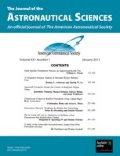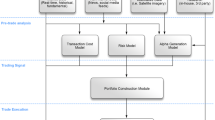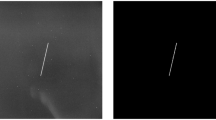Abstract
This work presents a data-driven method for the classification of light curve measurements of Space Objects (SOs) based on a deep learning approach. Here, we design, train, and validate a Convolutional Neural Network (CNN) capable of learning to classify SOs from collected light-curve measurements. The proposed methodology relies on a physics-based model capable of accurately representing SO reflected light as a function of time, size, shape, and state of motion. The model generates thousands of light-curves per selected class of SO, which are employed to train a deep CNN to learn the functional relationship. between light-curves and SO classes. Additionally, a deep CNN is trained using real SO light-curves to evaluate the performance on real data, but limited training set. The CNNs are compared with more conventional machine learning techniques (bagged trees, support vector machines) and are shown to outperform such methods, especially when trained on real data.












Similar content being viewed by others
References
Abbot, R.I., Wallace, T.P.: Decision support in space situational awareness. Lincoln Laboratory Journal 16(2), 297 (2007)
Kelso, T.: ”Satcat boxscore,” Celestrak: SATCAT Boxscore. Accessed April 19, vol. 16 (2017)
Linares, R., Jah, M.K., Crassidis, J.L., Nebelecky, C.K.: Space Object Shape Characterization and Tracking Using Light Curve and Angles Data,. J. Guid. Control. Dyn. 37(1), 13 (2013)
Hall, D., Calef, B., Knox, K., Bolden, M., Kervin, P.: Separating Attitude and Shape Effects for Non-resolved Objects,. In: The 2007 AMOS technical conference proceedings, pp. 464–475 (2007)
Jah, M., Madler, R.: Satellite Characterization: Angles and Light Curve Data Fusion for Spacecraft State and Parameter Estimation,. In: Proceedings of the advanced Maui optical and space surveillance technologies conference, vol. 49 (Wailea, Maui, HI). Paper E49 (2007)
Holzinger, M.J., Alfriend, K.T., Wetterer, C.J., Luu, K.K., Sabol, C., Hamada, K.: Photometric attitude estimation for agile space objects with shape uncertainty. J. Guid. Control. Dyn. 37(3), 921 (2014)
Linares, R., Shoemaker, M., Walker, A., Mehta, P.M., Palmer, D.M., Thompson, D.C., Koller, J., Crassidis, J.L.: Photometric Data from Non-Resolved Objects for Space Object Characterization and Improved Atmospheric Modeling. In: Advanced Maui optical and space surveillance technologies conference, vol. 1, vol. 1, p. 32 (2013)
Linares, R., Jah, M.K., Crassidis, J.L., Leve, F.A., Kelecy, T.: Astrometric and photometric data fusion for inactive space object feature estimation. In: Proceedings of 62nd international astronautical congress, international astronautical federation, vol. 3, pp. 2289–2305 (2011)
Gaylor, D., Anderson, J.: Use of Hierarchical Mixtures of Experts to Detect Resident Space Object Attitude. In: Advanced Maui optical and space surveillance technologies conference, vol. 1, p. 70 (2014)
Linares, R., Jah, M.K., Leve, F.A., Crassidis, J.L., Kelecy, T.: Astrometric and Photometric Data Fusion For Inactive Space Object Feature Estimation. In: Proceedings of the international astronautical federation (Cape Town, South Africa). Paper ID: 11340 (2011)
Linares, R., Jah, M.K., Crassidis, J.L.: Inactive Space Object Shape Estimation via Astrometric And Photometric Data Fusion. In: AAS/AIAA Space Flight Mechanics Meeting (Charleston, SC), AAS Paper 2012-117 (2012)
Linares, R., Jah, M.K., Crassidis, J.L.: Space Object Area-To- Mass Ratio Estimation Using Multiple Model Approaches. Adv. Astronaut. Sci. 144, 55 (2012)
Hinks, J.C., Linares, R., Crassidis, J.L.: Attitude Observability from Light Curve Measurements. In: AIAA Guidance, navigation, and control (GNC) conference (AIAA, Boston, MA). https://doi.org/10.2514/6.2013-5005 (2013)
Wetterer, C.J., Linares, R., Crassidis, J.L., Kelecy, T.M., Ziebart, M.K., Jah, M.K., Cefola, P.J.: Refining space object radiation pressure modeling with bidirectional re ectance distribution functions. J. Guid. Control. Dyn. 37(1), 185 (2013)
Linares, R., Crassidis, J.L.: Resident Space Object Shape Inversion via Adaptive Hamiltonian Markov Chain Monte Carlo. In: AAS/AIAA Space Flight Mechanics Meeting (Napa, CA), AAS Paper 2016-514 (2016)
LeCun, Y., Bengio, Y., Hinton, G.: Deep learning. Nature 521(7553), 436 (2015)
Lee, H., Pham, P., Largman, Y., Ng, A.Y.: Unsupervised feature learning for audio classification using convolutional deep belief networks. In: Advances in neural information processing systems, pp. 1096–1104 (2009)
Krizhevsky, A., Sutskever, I., Hinton, G.E.: Imagenet classification with deep convolutional neural networks. In: Advances in neural information processing systems, pp. 1097–1105 (2012)
Zhou, B., Lapedriza, A., Xiao, J., Torralba, A., Oliva, A.: Learning deep features for scene recognition using places database. In: Advances in neural information processing systems, pp. 487–495 (2014)
Karpathy, A., Toderici, G., Shetty, S., Leung, T., Sukthankar, R., Fei-Fei, L.: Large-scale video classification with convolutional neural networks. In: Proceedings of the IEEE conference on computer vision and pattern recognition, pp. 1725–1732 (2014)
Dietterich, T.G.: Ensemble methods in machine learning. In: International workshop. on multiple classifier systems. Springer, pp. 1–15 (2000)
Quinlan, J.R.: Induction of decision trees. Mach. Learn. 1(1), 81 (1986)
Hearst, M.A., Dumais, S.T., Osuna, E., Platt, J., Scholkopf, B.: Support vector machines. IEEE Intell Syst Appl 13(4), 18 (1998)
Breiman, L.: Random forests. Mach Learn 45(1), 5 (2001)
Ashikmin, M., Shirley, P.: An Anisotropic Phong Light Reflection Model. Tech. Rep. UUCS-00-014, University of Utah, Salt Lake City, UT (2000)
Shuster, M.D.: A Survey of Attitude Representations. J. Astronaut. Sci. 41(4), 439 (1993)
Kaasalainen, M., Torppa, J.: Optimization methods for asteroid lightcurve inversion: I. shape determination. Icarus 153(1), 24 (2001)
Linares, R., Crassidis, J.L., Jah, M.K.: Space object classification and characterization via multiple model adaptive estimation. In: 17th International conference on information fusion (FUSION) (IEEE), pp. 1–7 (2014)
Schaub, H., Junkins, J.L.: Analytical mechanics of space systems (American Institute of Aeronautics and Astronautics (2005)
Beskin, G., Karpov, S., Biryukov, A., Bondar, S., Ivanov, E., Katkova, E., Orekhova, N., Perkov, A., Sasyuk, V.: Wide-field optical monitoring with Mini-MegaTORTORA (MMT-9) multichannel high temporal resolution telescope. Astrophys. Bull. 72(1), 81 (2017)
Rawat, W., Wang, Z.: Deep convolutional neural networks for image classification: A comprehensive review. Neural Comput. 29(9), 2352 (2017)
LeCun, Y., Bottou, L., Bengio, Y., Haffner, P.: Gradient-based learning applied to document recognition. Proc. IEEE 86(11), 2278 (1998)
Mnih, V., Kavukcuoglu, K., Silver, D., Rusu, A.A., Veness, J., Bellemare, M.G., Graves, A., Riedmiller, M., Fidjeland, A.K., Ostrovski, G., et al.: Human-level control through deep reinforcement learning. Nature 518 (7540), 529 (2015)
Bengio, Y., Goodfellow, I., Courville, A.: Deep learning, vol 1 (Citeseer (2017)
Maaten, L.v.d., Hinton, G.: Visualizing data using t-SNE. J. Mach. Learn. Res. 9, 2579 (2008)
Van Der Maaten, L., Weinberger, K.: Stochastic triplet embedding. In: IEEE international workshop. on machine learning for signal processing. IEEE, vol. 2012, pp. 1–6 (2012)
Hall, D.T., Africano, J.L., Lambert, J.V., Kervin, P.W.: Time- Resolved I-Band Photometry of Calibration Spheres and NaK Droplets. J. Spacecr. Rocket. 44(4), 910 (2007)
Abadi, M., Agarwal, A., Barham, P., Brevdo, E., Chen, Z., Citro, C., Corrado, G.S., Davis, A., Dean, J., Devin, M., et al.: TensorFlow: Large-Scale Machine Learning on Heterogeneous Distributed Systems. arXiv:1603.04467 (2016)
Jolliffe, I.: Principal component analysis. In: International encyclopedia of statistical science. Springer, pp. 1094–1096 (2011)
Yosinski, J., Clune, J., Bengio, Y., Lipson, H.: How transferable are features in deep neural networks?. In: Advances in neural information processing systems, pp. 3320–3328 (2014)
Acknowledgment
The first author wishes to acknowledge support of this work by the Air Force’s Office of Scientific Research under Contract Number FA9550-18-1-0115.
Author information
Authors and Affiliations
Corresponding author
Ethics declarations
Conflict of interests
On behalf of all authors, the corresponding author states that there is no conflict of interest.
Additional information
Publisher’s Note
Springer Nature remains neutral with regard to jurisdictional claims in published maps and institutional affiliations.
Appendix A: Angular Velocity Determination Method
Appendix A: Angular Velocity Determination Method
This appendix provides a summary of the angular velocity determination method discussed in Ref. [28]. This work uses three possible control profiles, Sun pointing, Nadir pointing, and spin-stabilized. For each of these profiles the SO is control led to point to the Sun direction, the Nadir, or in a spin-stabilized configuration. For the spin-stabilized configuration, the desired angular velocity is chosen to be perpendicular to the orbital plane. When pointing in Sun direction or the Nadir direction we must compute the desired angular velocity to track these directions. If we assumed that \(\tilde {\textbf {b}}_{j_{k}}\) and \(\tilde {\textbf {b}}_{j_{k+1}}\) represent the jth pointing directions at time step. k and k + 1, then the goal is to estimate the angular velocity, ωk, from these directions. Both the Sun pointing and Nadir directions pointing are determined from the SO trajectories. The ωk is then estimated using a finite difference method which is outline below [28]. Ċonsider the following unit-vector measurement model at time tk:
where \(\tilde {\textbf {b}}_{j_{k}}\) is the jth pointing vector in the inertia frame and is rj the same pointing vector in the body frame. The attitude matrix mapping from inertial to the body frame is denoted by Ak. The goal is to determine the rate of change of this attitude matrix or the angular velocity. Taking the difference between successive measurements of Eq. 36 gives
We assume that the body angular velocity ω is constant between tk and tk+ 1, and ignore terms higher than first order in ωΔt. With these assumptions the following first-order approximation can be used [26]:
In this case ωk is the average velocity, but this becomes less of a problem as the sampling interval decreases. Substituting Eq. 38 into Eq. 37 gives
Our goal is to determine an angular velocity just using \(\tilde {\textbf {b}}_{j_{k}}\) and \(\tilde {\textbf {b}}_{j_{k+1}}\). This is accomplished by solving Eq. 36 in terms of Akri and substituting the resultant into Eq. 39, which yields
where \(\textbf {w}_{j_{k}}\) is the new effective measurement noise vector but for this work we assume this is zero. Note that Δt will have finite values, since discrete-time measurements are assumed. Equation 40 can now be cast into a linear least-squares form for all measurement vectors, which leads to
where \(\hat {\boldsymbol {\omega }}_{k}\) is the estimate of ωk. For this work we assume \(R_{j_{k}}^{-1}=I_{3 \times 3}\).
Rights and permissions
About this article
Cite this article
Linares, R., Furfaro, R. & Reddy, V. Space Objects Classification via Light-Curve Measurements Using Deep Convolutional Neural Networks. J Astronaut Sci 67, 1063–1091 (2020). https://doi.org/10.1007/s40295-019-00208-w
Published:
Issue Date:
DOI: https://doi.org/10.1007/s40295-019-00208-w




